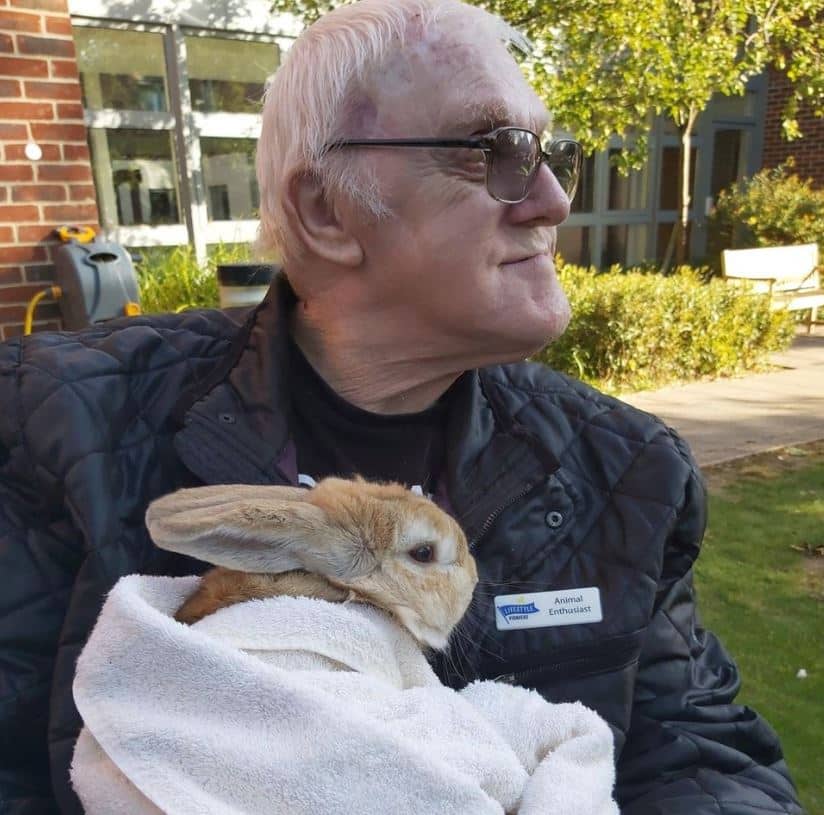Anyone with a pet will know just how relaxing and calming spending time with their animal can be. As well as relieving the feelings of loneliness and isolation, pets can reduce stress, lower blood pressure and promote a sense of overall wellbeing. With such a powerful range of physical and mental benefits, it’s not surprising that pet therapy is being introduced into many care homes to improve the lives of elderly people and dementia patients across the UK.
Westgate Healthcare is one example of a care home that has embraced pet therapy with open arms. They have seen visits from dogs, rabbits, owls and even reptiles in recent months, with residents able to care for and cuddle the animals in one-to-one therapy sessions. In this article, we’ll look in more detail at the many benefits of pet therapy for the elderly and learn how it can reach dementia patients and those who may not respond to other treatments.

Pet Therapy for the Elderly
Research has shown that pet owners generally take less medication, visit the doctor less frequently, cope with stress better, recover from illness more quickly and are less likely to feel lonely. One study revealed that spending just 15 minutes with an animal was enough to increase the level of the feel-good hormone serotonin in the brain and reduce levels of stress.
The emotional, mental and physical benefits of spending time with animals are felt by people of all ages. That’s why pet therapy can be useful for children having medical procedures, people undergoing chemotherapy, those with mental health disorders and patients who are in rehabilitation after surgery. However, it’s the increased risk of loneliness and isolation among older people that makes pet therapy for the elderly particularly effective.
There are several different forms pet therapy for the elderly can take. Visitation therapy, where animals visit older people at their care home, is the most common. Ownership therapy, where an elderly person owns and looks after a pet, and animal-assisted therapy, for those requiring intense physical rehabilitation, are also becoming increasingly popular.
The animals involved in pet therapy range from domesticated cats and dogs to farm animals and rabbits, birds, guinea pigs and even donkeys. Before they can be used for therapy, the animals must go through a basic obedience course, be therapy trained and be taught how to interact with elderly people with limited mobility.

The Physical Benefits of Pet Therapy
There are some impressive physical benefits that elderly people can reap from pet therapy. Although they differ depending on the type of therapy involved, they typically include:
- Increased levels of mobility
- Reduced blood pressure
- Improved motor skills
- Increased motivation to move farther and exercise for longer

The Emotional and Mental Benefits of Pet Therapy
Although the physical benefits of pet therapy for dementia patients and elderly people are profound, the biggest boost is to their mental and emotional health. The benefits include:
- Increased mental stimulation
- An enhanced sense of purpose and meaning
- A calming of the negative behaviours associated with dementia
- Reduced risk of depression
- Improved social skills
- Lower levels of stress and anxiety
- The stimulation of memories and a chance to reminisce
- A sense of responsibility
Making Everyday Life Better
Pet therapy has had to take a step back in recent months as care homes battle the coronavirus, but with the myriad of amazing benefits it can provide for the body and mind, it’s sure to become an increasingly popular therapy in the future.
As well as being a wonderful alternative for older people who love animals, pet therapy for the elderly can reach those with cognitive impairments who may not respond to other treatments. That makes this unique and cost-effective form of therapy a welcome addition to care homes and nursing homes of every type.
